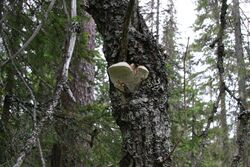Biology:Haploporus (fungus)
| Haploporus | |
|---|---|

| |
| Haploporus odorus | |
| Scientific classification | |
| Kingdom: | |
| Division: | |
| Class: | |
| Order: | |
| Family: | |
| Genus: | Haploporus Bondartsev & Singer (1944)
|
| Type species | |
| Haploporus odorus (Sommerf.) Bondartsev & Singer (1944)
| |
| Synonyms[1] | |
| |
Haploporus is a genus of poroid fungi in the family Polyporaceae.
Taxonomy
The genus Haploporus was circumscribed by mycologists Appollinaris Semenovich Bondartsev and Rolf Singer in 1944 with Haploporus odorus as the type, and only species.[2] The name Haploporus is derived from the Greek words απλόος ("simple"), and πόρος ("pore").[3]
Yu-Cheng Dai and colleagues treated the genus Pachykytospora as a synonym of Haploporus in 2002,[4] and then in subsequent publications.[5][6] Marcin Piątek proposed dividing Haploporus into two sections: sect. Haploporus (cap-like fruit bodies), and sect. Pachykytospora (crust-like fruit bodies).[7] Leif Ryvarden, who adopts a "pragmatic and conservative generic concept" in his 2014 work on European polypores, treats Haploporus as monotypic, containing only H. odorus.[8]
Using Haploporus tuberculosis as a representative generic exemplar, molecular analysis showed Haploporus to be nested within the core polyporoid clade, a phylogenetic grouping of fungi roughly equivalent to the family Polyporaceae.[9]
Description
Haploporus species have an annual to perennial growth habit. They are crust like, with sessile or effused-reflexed (crust like with outside edges extended to form caps) fruit bodies. The hyphal system of Haploporus is dimitic to trimitic; the generative hyphae have clamp connections. The spores are oblong ellipsoid to roughly spherical, ornamented, thick-walled and cyanophilous.[10]
Habitat and distribution
Haploporus fungi cause a white rot.[10]
Species
(As of January 2018), Index Fungorum accepts 6 species of Haploporus,[11] retaining Pachykytospora as an independent genus. In a 2016 taxonomic and phylogenetic study of the genus, Chinese scientists accept 13 species, including three newly described species from China.[10]
- Haploporus alabamae (Berk. & Cooke) Y.C.Dai & Niemelä (2002)
- Haploporus amarus X.L.Zeng & Y.P.Bai (1993)[12] – China
- Haploporus cylindrosporus L.L.Shen, Y.C.Dai & B.K.Cui (2016) – China[10]
- Haploporus latisporus Juan Li & Y.C.Dai (2007)[6] – China
- Haploporus nanosporus (A.David & Rajchenb.) Piątek (2005)[7]
- Haploporus nepalensis (T.Hatt.) Piątek (2003)[13] – Europe
- Haploporus odorus (Sommerf.) Bondartsev & Singer (1944)[2]
- Haploporus papyraceus (Cooke) Y.C.Dai & Niemelä (2002)
- Haploporus septatus L.L.Shen, Y.C.Dai & B.K.Cui (2016) – China[10]
- Haploporus subpapyraceus L.L.Shen, Y.C.Dai & B.K.Cui (2016) – China[10]
- Haploporus subtrameteus (Pilát) Y.C.Dai & Niemelä (2002)
- Haploporus thindii (Natarajan & Koland.) Y.C.Dai (2005)[5] – China; India[14]
- Haploporus tuberculosis (Fr.) Niemelä & Y.C.Dai (2002)
References
- ↑ "Synonymy: Haploporus Bondartsev & Singer". Species Fungorum. CAB International. http://www.speciesfungorum.org/Names/SynSpecies.asp?RecordID=17722. Retrieved 2015-10-29.
- ↑ 2.0 2.1 Singer, R. (1944). "Notes on taxonomy and nomenclature of the polypores". Mycologia 36 (1): 65–69. doi:10.2307/3754880. http://www.cybertruffle.org.uk/cyberliber/59350/0036/001/0065.htm.
- ↑ Donk, M.A. (1962). "The generic names proposed for Polyporaceae. Additions and corrections". Persoonia 2 (2): 201–210. http://www.repository.naturalis.nl/document/570139.
- ↑ Dai, Yu-Cheng; Niemelä, Tuomo; Kinnunen, Juha (2002). "The polypore genera Abundisporus and Perenniporia (Basidiomycota) in China, with notes on Haploporus". Annales Botanici Fennici 39 (3): 169–182. http://www.sekj.org/PDF/anbf39/anbf39-169p.pdf.
- ↑ 5.0 5.1 Yu, Chang-Jun; Zuo, Li; Dai, Yu-Cheng (2005). "Three polypores from Xizang new to China". Fungal Science 20 (3–4): 61–68. http://web2.nmns.edu.tw/TFungi/chinese/data_all/chinese_pdf/chinese2034/2034-1.pdf.
- ↑ 6.0 6.1 Li, J.; Dai, Y.C.; Yuan, H.S. (2007). "A new species of Haploporus (Basidiomycotina) from China". Mycotaxon 99: 181–187. http://www.cybertruffle.org.uk/cyberliber/59575/0099/0181.htm.
- ↑ 7.0 7.1 Piatek, Marcin (2005). "Taxonomic position and world distribution of Pachykytospora nanospora (Polyporaceae)". Annales Botanici Fennici 42 (1): 23–25.
- ↑ Ryvarden, L.; Melo, I. (2014). Poroid Fungi of Europe. Synopsis Fungorum. 31. Oslo, Norway: Fungiflora. pp. 12; 206. ISBN 978-8290724462.
- ↑ Binder, Manfred; Justo, Alfredo; Riley, Robert; Salamov, Asaf; Lopez-Giraldez, Francesc; Sjökvist, Elisabet; Copeland, Alex; Foster, Brian et al. (2013). "Phylogenetic and phylogenomic overview of the Polyporales". Mycologia 105 (6): 1350–1373. doi:10.3852/13-003. PMID 23935031.
- ↑ 10.0 10.1 10.2 10.3 10.4 10.5 Shen, Lu-Lu; Chen, Jia-Jia; Wang, Ming; Cui, Bao-Kai (2016). "Taxonomy and multi-gene phylogeny of Haploporus (Polyporales, Basidiomycota)". Mycological Progress 15 (7): 731–742. doi:10.1007/s11557-016-1203-y.
- ↑ Kirk, P.M.. "Species Fungorum (version 20th December 2017) . In: Species 2000 & ITIS Catalogue of Life". http://www.catalogueoflife.org/col/browse/tree/id/57ebfe648e8c1471cbe6151f68a38415. Retrieved 2018-01-05.
- ↑ Zeng, X.L.; Bai, Y.P. (1993). "The genus Haploporus in China". Acta Mycologica Sinica 12 (2/3): 12–15.
- ↑ Piatek, M. (2003). "Haploporus tuberculosis, a new polypore genus and species in Belarus, with a new combination in Haploporus". Polish Botanical Journal 48 (1): 81–83.
- ↑ Natarajan, K.; Kolandavelu, K. (1993). "A new species of Pachykytospora Kotl. et Pouz. from India". Cryptogamic Botany 3: 195–196.
Wikidata ☰ Q35007262 entry
 |

